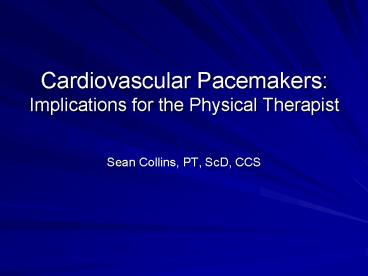Cardiovascular Pacemakers: Implications for the Physical Therapist PowerPoint PPT Presentation
1 / 24
Title: Cardiovascular Pacemakers: Implications for the Physical Therapist
1
Cardiovascular PacemakersImplications for the
Physical Therapist
- Sean Collins, PT, ScD, CCS
2
Why a pacemaker?Synchrony of the Atria
Ventricles (AV Synchrony) is important for both
diastolic systolic function
3
Indications for Pacemaker
- Class I
- 1. Sinus node dysfunction with documented
symptomatic bradycardia - 2. Symptomatic chronotropic incompetence (failure
to increase HR with exercise or increased
metabolic demand) - 3. 3 and advanced 2 AV block associated with
any of the following - Arrhythmias that require drugs resulting in
symptomatic bradycardia - Sinus pauses gt 3 seconds
- Asymptomatic escape rate lt 40bpm while awake
- 4. 3 or 2 AV block with associated symptomatic
bradycardia - 5. Type II 2 AV block with wide QRS, regardless
of symptoms
From K Dias, Maryville U
4
Indications for Pacemaker
- Class IIa
- 1. Syncope of unexplained origin when major
abnormalities of sinus node function are
discovered or provoked during EP studies. - 2. Asymptomatic 3 AV block with an awake
ventricular rate gt 40bpm - 3. Asymptomatic type II 2 AV block
From K Dias, Maryville U
5
Pacemaker Codes
From K Dias, Maryville U
6
Pacemaker ConfigurationsVOO
Indications Temporary mode some-times used during
surgery to prevent interference from
electrocautery
From K Dias, Maryville U
7
Pacemaker ConfigurationsVVI
Indications The combination of AV block and
chronic atrial arrhythmias (particularly atrial
fibrillation).
From K Dias, Maryville U
8
Pacemaker ConfigurationsAAI
Indications Sick sinus syndrome in the absence of
AV node disease or atrial fibrillation.
9
Pacemaker ConfigurationsVDD
Indications AV block with intact sinus node
function (particularly useful in congenital AV
block).
From K Dias, Maryville U
10
Pacemaker ConfigurationsDDD
Indications 1. The combination of AV block and
SSS. 2. Patients with LV dysfunction and LV
hypertrophy who need coordination of atrial and
ventricular contractions to maintain adequate CO.
From K Dias, Maryville U
11
Rate Response
- Rate responsive (also called rate modulated)
pacemakers provide patients with the ability to
vary heart rate when the sinus node cannot
provide the appropriate rate - Rate responsive pacing is indicated to prevent
chronotropic incompetence (heart rate cannot
reach appropriate levels during exercise or to
meet other metabolic demands)
12
Rate Response
- Why does heart rate respond?
- Allostatic demands
- Metabolic fluctuations
- BP buffering
- Need for variation in Cardiac Output
- Ashbys Law of Requisite Variety
13
Rate Responsive Pacing
- Cardiac output (CO) is determined by the
combination of stroke volume (SV) and heart rate
(HR) - SV X HR CO
- VO2 CO x (a-v)O2 difference
- Sustainable workload a max VO2
- (BP CO x Peripheral Resistance)
14
Changes in cardiac output attempt to match
metabolic requirements
15
Rate Responsive Pacing
- SV reserves can account for increases in cardiac
output of up to 50 - HR reserves can nearly triple total cardiac
output in response to metabolic demands
16
(No Transcript)
17
Assessing Rate Response
- Pulse
- ECG
- HR monitor
- Pulsed Oximeter
- Auscultation
- Consider not only current (point estimate) rate
by temporal changes - 60 second rate first/last 10 seconds
- Consider rhythm if abnormal, ECG
18
Rate Response Sensors
- Activity sensors detect physical movement and
increase the rate according to the level of
activity - Physiological Sensors
- Minute ventilation
- QT Interval Sensors
19
Sensor Implications
- HR response depends on sensor function in total
demand pacing - If Activity based seated exercise, bicycling,
may not induce a HR response - Assess response with warm up
- Assess relationship between rate response and
- Symptoms
- Blood Pressure
- If there are questions observe the ECG with
exercise
20
PT Pacer Implications
- Is the pacer working as it should?
- If not as it should, document observations and
measures speak with cardiologist - If it is working as it should is it optimal?
- If not optimal, document observations and
measures speak with cardiologist - Incorporate presence of pacer into evaluation
(prognosis) and intervention (how does the pacer
respond and enable increased workload)
21
For your records --
From Collins Cahalin, 2005
22
- Case I
- 56 yo Male s/p transplant and rejection
worsening LV function (EF 36 to 18 in 10
months) DDDR Pacemaker - HR started declining as he reached symptom
limited workloads - Associated with drops in SPB
- Started occurring at lower absolute workloads
- What to do?
23
Case II 80 yo Female, h/o CHF, AFib, CAD, et al
VVIR pacemaker -s/p long acute care stay -very
weak, de conditioned -experienced symptom
limiting fatigue soon after starting ambulation
(within 15 seconds) no increase in SBP, no
increase in HR c/o fatigue SOB What to do?
24
Case III 72 yo Male, s/p PTCA, SOB, Fatigue with
minimal exertion -Independent with all BADLs
and IADLs 3 days ago -limited after short
distances of ambulation (otherwise
independent) What to do?

